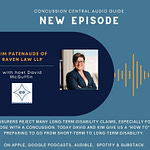Episode 4
Concussion patients often struggle to find care, especially if their symptoms continue longer than expected.
We’ve brought Dr. Shannon Bauman back to the show. She gives us some helpful tips for going to medical appointments. Importantly, we ask Dr. Bauman what the best way is to talk with our family physicians about our concussions. We wanted to understand the gaps in knowledge between patients and medical professionals. What are the differences between an acute concussion and a persistent concussion? We wanted to talk about concussion symptoms, who can help us resolve them, and how we can better map out pathways through the medical system.
Dr. Bauman talks about the vision of the Ontario Neurological Foundation. People suffering from concussions should have “the right care, delivered at the right time, by the right provider,” a vision Concussion Central believes.
Today we’re beginning a big topic. We know that we’ll be returning to it repeatedly over time. Improving patient experience is key to helping manage acute and persistent symptoms, but finding a clear path through symptoms, medical and healthcare professionals can be demanding. Dr. Bauman mentions that patients may consult between 6 to 10 medical professionals before finding the proper care.
Today, the podcast covers definitions of concussions, acute, subacute, and persistent. David and Dr. Bauman discuss “triggers” that bring on symptoms and their role in creating a pathway to recovery. She talks about “Points of Access” and how concussion patients enter the healthcare system – emergency rooms, family physicians, occupational therapists, and others.
Along with our discussion on the podcast, we will be pulling information on concussions and concussion management from resources developed by the Concussion Ontario and the Ontario Neurological Foundation. The Foundation no longer exists, it wound down in 2021, yet its standards and guidelines remain some of the more authoritative we have. Dr. Bauman, along with many others, helped develop and prepare these guidelines. She refers to these documents because they are the accepted standards in Ontario.
Points of Access: Getting Diagnosed and Assessed - who can help you with your injury. (Brain Injury Guidelines portal)
The Pathway through the Healthcare System (Concussion Ontario)
Dr. Bauman refers to her Concussion Passport; she created this tool in her clinic with the help of her team. We refer to it only because it represents another tool to help guide patients through their injuries. It is not available for purchase currently.
They are available to all at the following sites: concussionontario.org & braininjuryguidelines.org.
Any information Concussion Central posts holds the same caution expressed on the Brain Injury Guidelines portal, “The content of the Guideline for Concussion/mTBI & Prolonged Symptoms, 3rd Edition: for Adults over 18 years, is based on the status of scientific knowledge available at the time of their finalization (2017) as well as on the consensus of the experts who participated in the guideline development.
Choices reflected in these guidelines do not preclude the possibility of other approaches or practices also being valid and relevant. Healthcare professionals must use their clinical judgment and consider other factors such as patient preferences, contextual factors, and resource availability in applying these recommendations. Moreover, healthcare professionals must at all times respect the legal and normative regulations of the regulatory bodies, particularly regarding scopes of practice and restricted/protected activities, as these may differ by jurisdiction.”











Share this post